Afro-Asians
Afro-Asians or African-Asians, are persons of mixed Asian and African ancestry.[1] Historically, Afro-Asian populations have been marginalised as a result of human migration and social conflict.[2]
| Total population | |
|---|---|
| Official global population numbers are unknown.
| |
| Regions with significant populations | |
| North America, South America, Caribbean, Africa |
Africa
Democratic Republic of the Congo
Katanga Afro-Japanese
During the 1970s, an increased demand for copper and cobalt attracted Japanese investments in the mineral-rich southeastern region of Katanga Province. Over a 10-year period, more than 1,000 Japanese miners relocated to the region, confined to a strictly male-only camp. Arriving without family or spouses, the men often sought social interaction outside the confines of their camps. In search of intimacy with the opposite sex, resulting in cohabitation, the men openly engaged in interracial dating and relationships, a practice embraced by the local society. As a result, a number of Japanese miners fathered children with Native Congolese women. However, most of the mixed race infants resulting from these unions died, soon after birth. Multiple testimonies of local people suggest that the infants were poisoned by a Japanese lead physician and nurse working at the local mining hospital. Subsequently, the circumstances would have brought the miners shame as most of them already had families back in their native Japan. The practice forced many native Katangan mothers to hide their children by not reporting to the hospital to give birth.
Today, fifty Afro-Japanese have formed an association of Katanga Infanticide survivors. The organization has hired legal counsel seeking a formal investigation into the killings. The group submitted an official inquiry to both the Congolese and Japanese governments, to no avail. Issues specific to this group include having no documentation of their births since not having been born in the local hospital spared their lives. The total number of survivors is unknown.[Africa-Congo 1]
Equatorial Guinea
The mid-19th century saw about 500 Chinese laborers and indentured servants, along with a handful from India stealthily imported to the island of Fernando Po through the once Portuguese owned Macau.[Africa-EQ 1] While most of these servants returned to their homelands at the end of their servitude, a few remained, settling and marrying into the local population. One example is immigrant East Indian laborer Francisco Kashu Alimama who remained in Moka after the death of his last living relative. He married the daughter of one of the last Bubi kings, producing several Indo-Equatoguinean children.
Kenya
Zheng He's fleet
In 1999, Nicholas Kristof of The New York Times reported a surprising encounter on the island of Pate, where he found a village of stone huts. He talked to an elderly man living in the village who said that he was a descendant of Chinese explorers who were shipwrecked there centuries before. The Chinese had supposedly traded with the locals and had even loaded giraffes onto their ship to take back to China. However, the Chinese ran aground on a nearby reef. Kristof found evidence that confirmed the man's story. Such evidence included the Asian features of the people in the village, plus Asian-looking porcelain artifacts.[Africa-Kenya 1][Africa-Kenya 2] These descendants of Zheng He's fleet occupy both Pate and Lamu Islands.
New immigration
New interest in Kenya's natural resources has attracted over $1 billion of investment from Chinese firms. This has propelled new development in Kenya's infrastructure with Chinese firms bringing in their own male workers to build roads.[Africa-Kenya 3] The temporary residents usually arrive without their spouses and families. Thus, a rise of incidents involving local college-aged females has resulted in an increased rate of Afro-Chinese infant births to single Kenyan mothers.[Africa-Kenya 4]
In Kenya there's worrying trend of the following influx of Chinese male workers in Kenya with a growing number of abandoned babies of Chinese men who fathered children with local women.[3]
Madagascar
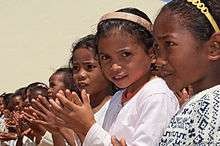
The population of Madagascar is primarily a mixture of various degrees of Austronesian and Bantu settlers from Southeast Asia (Borneo) and Southeast Africa (primarily Mozambique), respectively. Years of intermarriages created the Malagasy people. They primarily speak Malagasy, an Austronesian language with some Bantu influences.
In the study of "The Dual Origin of the Malagasy in Island Southeast Asia and East Africa: Evidence from Maternal and Paternal Lineages" shows the Bantu maternal origin to be 38% and Paternal 51% while the Southeast Asian paternal to be 34% and maternal 62%.[Africa-Madagascar 1] In the study of Malagasy, autosomal DNA shows the highlanders ethnic group like Merina are almost an even mixture of Southeast Asian and Bantu origin, while the coastal ethnic group have much higher Bantu mixture in their autosomal DNA suggesting they are mixture of new Bantu migrants and the already established highlander ethnic group. Maximum-likelihood estimates favour a scenario in which Madagascar was settled approximately 1,200 years ago by a very small group of women of approximately 30.[Africa-Madagascar 2] The Malagasy people existed through intermarriages between the small founding population.
Intermarriage between Native Malagasy women and Chinese men were not uncommon.[Africa-Madagascar 3] Several thousand Cantonese men intermarried and cohabited with Malagasy women. 98% of the Chinese traced their origin from Guangdong, specifically the Cantonese district of Shunde. For example, the census alone in 1954 census found 1,111 "irregular" Chinese-Malagasy unions and 125 legitimate, i.e., legally married, partnerships. Most offspring were registered by their mothers under a Malagasy name.
Mauritius
Approximately 68% of the population is of Indian origin. About 25% of the population is Creole (of mixed French and African descent) and there are small numbers of people of Franco-Mauritian and Chinese descent.
Nigeria
Since the 1970s, Nigeria has seen a slow, but steady, increase in the immigrant Filipino population drawn by the oil industry. Established in 1973, the Philippine Barangay Society of Nigeria addresses issues specific to over 1,700 Nigerized Filipinos living in the country. This acculturation has resulted in a small but growing, number of biracial Nigerian Filipinos births. Most of these children are parented by Filipino mothers and Nigerian fathers.[Africa-Nigeria 1]
Réunion
The Native Kaf population has a diverse range of ancestry stemming from colonial Indian and Chinese peoples. They also descend from African slaves brought from countries like Mozambique, Guinea, Senegal, Madagascar, Tanzania and Zambia to the island.
Most population of Réunion Creoles who are of mixed ancestry and make up the majority of the population. Interracial marriages between European men and Chinese men with African women, Indian women, Chinese women, Madagascar women were also common. In 2005, a genetic study on the racially mixed people of Réunion found the following. For maternal (mitochondrial) DNA, the haplogroups are Indian (44%), East Asian (27%), European/Middle Eastern (19%) or African (10%). The Indian lineages are M2, M6 and U2i, the East Asian ones are E1, D5a, M7c, and F (E1 and M7c also found only in South East Asia and in Madagascar), the European/Middle Eastern ones are U2e, T1, J, H, and I, and the African ones are L1b1, L2a1, L3b, and L3e1.[4]
For paternal (Y-chromosome) DNA, the haplogroups are European/Middle Eastern (85%) or East Asian (15%). The European lineages are R1b and I, the Middle Eastern one E1b1b1c (formerly E3b3) (also found in Northeast Africa), and the East Asian ones are R1a (found in many parts of the world including Europe and Central and Southern Asia but the particular sequence has been found in Asia) and O3.[4]
Seychelles
More than 70% of the native population has Afro-Asian ancestry stemming from African, Malagasy, Indian and Chinese peoples, combined with additional British and French origins. However, the demographic is specifically proud of their African/Malagasy heritage and have formed an institute promoting their identity and cultural tolerance.
South Africa
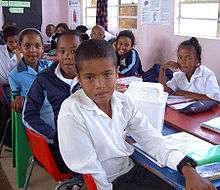
The Cape Coloured population descend from Indigenous Khoisan and Xhosa peoples; European immigrants and Malagasy, Ceylonese and Southeast Asian (primarily Indonesian) laborers and slaves brought by the Dutch from the mid-17th century to the late 18th century. The majority of Coloureds, particularly in the Western Cape and Northern Cape, speak Afrikaans as a first language, while those in other parts of South Africa tend to speak English as well. Coloureds with Javanese or other Indonesian ancestry may often be regarded as Cape Malay and are primarily Muslims, while the majority of Coloureds are Christian (generally Protestant) or agnostic. Due to similar social adversities experienced under the Apartheid regime from the late 1940s to the late 1980s, Coloured and Indigenous South African communities generally fall under the black social category when it comes to employment and affirmative action policies.[Africa-South-Africa 1]
DNA of South Africa's ethnic groups
The mtDNA study of ethnic people from South Africa shows substantial African genetic mtDNA contribution in both the Cape Malay and South African Indians. mtDNA of Cape Malay shows 10% African mtDNA contribution in their gene pool including 20% (1 in 5) of South African Indians; there appears to be no African Y-DNA contribution detected but this could be due to the fact that the sample size was small. mtDNA study also revealed that about 1 in 10 South African Black people have mtDNA lineages derived from Eurasian (3.0%) and Asian of Indian origins (7.1%).[Africa-South-Africa 2]
Cape Coloureds
There is a significant genetic mixture of European, African, Indian and East/Southeast Asian DNA in the modern ethnic group of Cape Coloured. The highest genetic contribution to the Cape Coloured is from African maternal mtDNA displaying very high frequencies at 79.04%, followed by African Paternal Y-DNA frequencies at 45.18%. European Genetic contribution is the second highest after Africans with a high frequency of 37.72% from European Y-DNA but with a low contribution of European mtDNA at 4.26%. The Indian genetics also displayed significant frequencies, the mtDNA contribution stands at 13.85% and Y-DNA at 9.65% and lastly the East/Southeast Asian Y-DNA in the Cape Coloured also displayed a significant frequency at 8.54% but with a very low contribution of Southeast/East Asian mtDNA at only 1.6%, some of the Southeast Asian contributions from the Cape colored gene pool may have partially derived from both East/Southeast Asian and Malagasy who both also exhibit haplogroups O1a and O2a and B4a, B5a, F1c. The only exception of the completely Southeast/East Asian lineage in Cape Coloured are haplogroup O3-M122 (3.58%) and K-M9 (1.32%) both which are found among Chinese and Southeast Asians but not among the Malagasy.[5]
The Americas
Central and South America
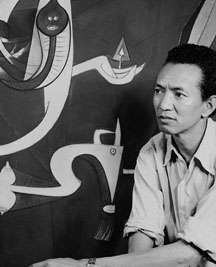
In Central and South America, significant numbers of Chinese first started arriving in the mid-19th century as part of the Coolie slave trade. By the mid-20th century, Cuba and Peru had the largest Chinese populations. By the end of WWII, there were considerable high numbers of Central and South America descended from local women and Chinese fathers. One of the most famous of these is the Afro-Chinese-Cuban artist Wifredo Lam, known as the Cuban Picasso. There are also small numbers of Central and South American residents of African and Asian descent in countries like Puerto Rico, Haiti and the Dominican Republic.
Cuba
About 120,000 Cantonese coolies, all males, entered Cuba under contract for 80 years; most did not marry, but Hung Hui (1975:80) cites there was a frequency of sexual activity between black women and Cantonese coolies. According to Osberg (1965:69) the free Chinese conducted the practice of buying slave women and freeing them expressly for marriage. In the 19th and 20th centuries, Chinese men (Cantonese) engaged in sexual activity with both White and Black Cuban women and from such relations many children were born. (For a British Caribbean model of Chinese cultural retention through procreation with black women, see Patterson, 322-31).[Americas-Cuba 1]
In the 1920s an additional 30,000 Cantonese and small groups of Japanese also arrived; both immigrations were exclusively male and there was rapid intermarriage with white, black and mulato populations.[Americas-Cuba 2] The CIA World Factbook Cuba, in 2008, claimed a population of 114,240 Chinese-Cubans, with only 300 being pure Chinese.[Americas-Cuba 3]
In the study of genetic origin, admixture and asymmetry in maternal and paternal human lineages in Cuba, thirty-five Y-chromosome SNPs were typed in the 132 male individuals of the Cuban sample. The study does not include any people with some Chinese ancestry. All the samples were white and black Cubans. Two out of 132 male sample belong to East Asian Haplogroup O2, which is found in significant frequencies among Cantonese people, is found in 1.5% of the Cuban population.[Americas-Cuba 4]
One of Cuba's most known Afro-Asians is the artist Wifredo Lam.
Haiti
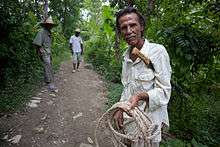
In Haiti, there is a sizable percentage within the minority who are of Asian descent. Haiti is also home to Marabou peoples, a half African and half East Indian people who descent from East Indian immigrants who arrived from other Caribbean nations, such Martinique and Guadeloupe and African slave descendants. Most present-day descendants of the original Marabou are products of hypodescent and, subsequently, mostly of African in ancestry.
The country also has a sizable Chinese-Haitian population. One of the country's most notable Afro-Asians is the late painter Edouard Wah who was born to an Afro-Haitian mother and a Chinese immigrant father. There are a small number of residents that have Japanese ancestry as well.
Peru
About 100,000 Cantonese coolies (almost all males) in 1849 to 1874 migrated to Peru and intermarried with Peruvian women of European, African, Amerindian, mestizo and mulatto origin. Many Peruvian Chinese today are of mixed Spanish, Amerindian and Chinese lineages. Among this population exist many of African slave lineage. Estimates for the Chinese-Peruvian population range from about 1.3–1.6 million. Asian-Peruvians are estimated to be 3% of the population, but one source places the number of citizens with some Chinese ancestry at 4.2 million, which equates to 15% of the country's total population.[Americas-Peru 1]
Brazil
Brazil has the largest Japanese community outside Japan and a large Chinese and Korean minority as well. The country's brown population, which includes mixed race mestizo and mulatto Brazilians, is almost half of the entire population and it also includes people of Eurasian, Gypsy and indigenous descent. Interracial marriages between Asians, mostly Japanese and Brazilians of African descent are less common than those between East Asians and Brazilians of European, Arab and Jewish descent, which are not uncommon and known as hāfu or ainoko. Most East Asians live in São Paulo and Paraná. Afro-Asians can be found in Rio de Janeiro where there is a sizeable Chinese minority as well as Vietnamese and Indonesians and Bahia where the majority of blacks live.
The West Indies

In the 1860s, East Indian and Chinese immigrants arrived in the West Indies as indentured servants. Chinese male laborers and migrants went to Peru, Cuba, Haiti, Guyana, Suriname, Jamaica and Trinidad where they often intermarried with local black women which resulted in a large population of racially mixed children. According to the 1946 Census from Jamaica and Trinidad alone, 12,394 Chinese were located between Jamaica and Trinidad. 5,515 of those who lived in Jamaica were Chinese-Jamaican and another 3,673 were Chinese-Trinidadians living in Trinidad. The Chinese men who married African women in Guyana and Trinidad Tobago were mostly Cantonese, while the Chinese men who married African women in Jamaica were mostly Hakka but with a large minority of Cantonese men. In her book and documentary Finding Samuel Lowe: China, Jamaica, Harlem, Afro-Chinese-Jamaican-American Paula Williams Madison explores her grandfather's life and travels. The journey ends with the reunion of the author's immediate relatives with their newly discovered extended family in Guangdong, China.[6] 1871 the census was recorded at a population of 506,154 people, 246,573 of which were males, and 259,581 females. Their races were recorded as 13,101 White, 100,346 Coloured (mixed Black and White), and 392,707 Blacks with a minority making up other races.[7]
Many thousands males of Europeans, Indian, Chinese descent married local Black African women. Pub Med results were also issued in the same year (2012): "Our results reveal that the studied population of Jamaica exhibit a predominantly South-Saharan paternal component, with haplogroups A1b-V152, A3-M32, B2-M182, E1a-M33, E1b1a-M2, E2b-M98, and R1b2-V88 making up 66.7% of the Jamaican paternal gene pool. Yet, European derived chromosomes (i.e., haplogroups G2a*-P15, I-M258, R1b1b-M269, and T-M184) were detected at commensurate levels in Jamaica (18.9%), whereas Y-haplogroups indicative of Chinese [O-M175 (3.8%)] and Indian [H-M69 (0.6%) and L-M20 (0.6%)] ancestry were restricted to Jamaica. African paternal DNA 66.7%, European paternal DNA 18.9%, Chinese paternal DNA 3.8%, Indian paternal DNA 1.2%[8]
In Jamaica, Guyana, Suriname and Trinidad, a percentage of the population of people are of Indian descent, some of whom have contributed to Afro-Asian-Caribbean children.
Guyana
During the mid-19th century, the British Empire imported approximately 14,000 Chinese indentured servants into Guyana as part of a broader colonial system aimed at recruiting sugar-plantation laborers. The majority of the male workers arrived without families, thus intermarried with local Indo-Guyanese and Afro-Guyanese women.
Trinidad and Tobago
The country is known for having a large Indian population stemming from the 18th- and 19th-century colonial plantation economy and people of Indian descent now make up a narrow plurality. In Trinidad and Tobago, persons of African-Indian mixed descent are called "douglas". One of the country's most notable Afro-Asians is its former President George Maxwell Richards and singer Nicki Minaj.
United States
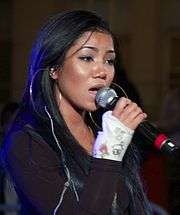 Jhené Aiko is of Spanish, Dominican, Japanese, Native American, African-American, German-American and Jewish descent.
Jhené Aiko is of Spanish, Dominican, Japanese, Native American, African-American, German-American and Jewish descent.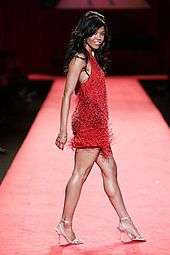 Amerie is of African-American and Korean descent.
Amerie is of African-American and Korean descent.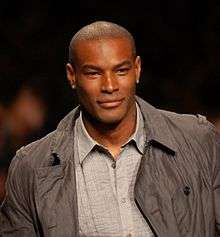 Tyson Beckford is of Panamanian-Jamaican and Chinese descent.
Tyson Beckford is of Panamanian-Jamaican and Chinese descent.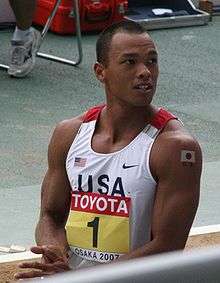 Bryan Clay is of African-American and Japanese descent.
Bryan Clay is of African-American and Japanese descent. Will Demps is of European, African-American and Korean descent.
Will Demps is of European, African-American and Korean descent.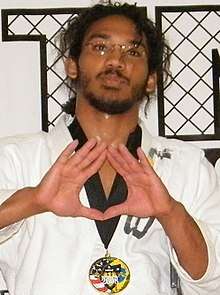 Benson Henderson is of African-American and Korean descent.
Benson Henderson is of African-American and Korean descent.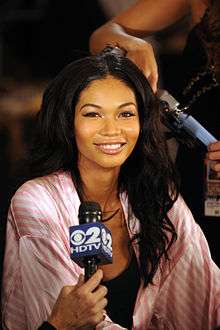 Chanel Iman is of African-American and Korean descent.
Chanel Iman is of African-American and Korean descent.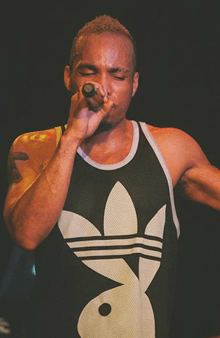 Anderson Paak is of African-American and Korean descent.
Anderson Paak is of African-American and Korean descent. Denyce Lawton is of African-American and Korean descent.
Denyce Lawton is of African-American and Korean descent. Ne-Yo is of African-American and Chinese descent.
Ne-Yo is of African-American and Chinese descent. Bobby Scott is of African-American and Filipino descent.
Bobby Scott is of African-American and Filipino descent.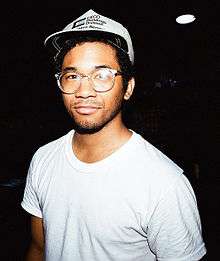 Toro y Moi is of African-American and Filipino descent.
Toro y Moi is of African-American and Filipino descent. Tiger Woods is of mixed Dutch, African-American, Native American, Chinese and Thai descent.
Tiger Woods is of mixed Dutch, African-American, Native American, Chinese and Thai descent. Tyga is of Jamaican and Vietnamese descent.
Tyga is of Jamaican and Vietnamese descent. Kelis is of African-American and Chinese-Puerto Rican descent.
Kelis is of African-American and Chinese-Puerto Rican descent. Cassie Ventura is of African-American, Mexican, West Indian and Filipino descent.
Cassie Ventura is of African-American, Mexican, West Indian and Filipino descent.
In 1882, the Chinese Exclusion Act was passed and Chinese workers who chose to stay in the U.S. could no longer be with their wives who stayed behind in China. Because White Americans looked at Chinese labor workers as stealing employment, they were harassed and discriminated against. Many Chinese men settled in black communities in states such as Mississippi[Mississippi-US 1] and, in turn, married black women.[Americas-US 2] In the mid-19th to 20th centuries, hundreds of thousands of Chinese men in the U.S., mostly of Cantonese origin from Taishan, migrated to the United States. Anti-miscegenation laws in many states prohibited Chinese men from marrying white women.[Americas-US 3] After the Emancipation Proclamation, many intermarriages in some states were not recorded and historically, Chinese-American men married African-American women in high proportions to their total marriage numbers due to few Chinese-American women being in the United States. After the Emancipation Proclamation, many Chinese-Americans immigrated to the Southern states, particularly Arkansas, to work on plantations. For example, in 1880, the tenth US Census of Louisiana alone counted 57% of interracial marriages between these Chinese Americans to be with African Americans and 43% to be with European-American women.[Americas-US 4] Between 20 and 30 percent of the Chinese who lived in Mississippi married black women before 1940.[Americas-US 5] In a genetic study of 199 samples from African-American males found one belong to haplogroup O2a (or 0.5%).[9]
Other notables

It was discovered by historian Henry Louis Gates Jr. in the African American Lives documentary miniseries that NASA astronaut Mae Jemison has a significant (above 10%) genetic East Asian admixture. Gates speculated that the intermarriage/relations between migrant Chinese workers during the 19th century and black or African-American slaves or ex-slaves may have contributed to her ethnic genetic make-up. In the 1960s census showed 300 Chinese men married to black women and vice versa also 100.[10] Born to a Japanese mother and an African-American U.S. military personnel father, sisters Titi and Miko Branch, founders of Miss Jessie's, were pivotal in revolutionizing the black hair care industry, negotiating business deals that opened the door for a new wave of black created and owned hair and beauty product lines to be sold in major retailers including Target, Walmart and Walgreens.
U.S. Census reports
According to the 2010 United States Census, there are 185,595 people of Native African or African-American and Asian descent in the United States. Reports further offer the following break-down of all groups having Native African or African-American and Asian descent:
|
|
Central Asia
Afghanistan
Among the ethnic Hazara people who were descendants of Mongol invaders who mixed with the Iranian population it detected Sub-Saharan African lineages in both the paternal and maternal ancestry of Hazara. Among the Hazara's there are 7.5% of African mtDNA haplogroup L with 5.1% of African Y-DNA B.[11][12] The origin and date of when these admixture occurred are unknown but was believed to have been during the slave trades in Afghanistan.[12]
East Asia
China

Contemporary China
Currently, Afro-Asian births are on the rise resulting from the arrival of African students in cities such as Nanjing, Hangzhou and Shanghai. Another contributing factor is the strengthened trade relationships between Africa and China which have invited an influx of African immigrants into China, primarily Nigerians who have formed a small, yet progressive, community in the country.[Asia-China 1] In October 2010, Chinese officials estimated about 500 mixed marriages between Africans and Chinese.[Asia-China 2] In places such as Guangzhou, a progressive population of about 10,000 African entrepreneurs continues to thrive.[Asia-China 3]
Majority of the Chinese who live and marry Africans in Guangzhou come from the poorer provinces Sichuan, Hunan, Hubei.[13][14]
China's new emerging population of Afro-Asians also includes Pate and Lamu Island descendants of ancient shipwrecked Chinese explorers. Awarded Chinese citizenship by the Chinese government, many students have been provided full scholarships to universities in China.[Asia-China 4] Among China's most famous Afro-Asian natives are Shanghai-born Lou Jing who, in 2009, garnered national gossip as she rose to fame competing on popular reality TV show Dragon TV's Go Oriental Angel[Asia-China 5] and half-South African and half-Chinese volleyball player Ding Hui.
Japan
 African-American-Korean singer and actress Crystal Kay
African-American-Korean singer and actress Crystal Kay.jpg) Beninese-Japanese basketball player Rui Hachimura
Beninese-Japanese basketball player Rui Hachimura African-American-Japanese basketball player Michael Takahashi
African-American-Japanese basketball player Michael Takahashi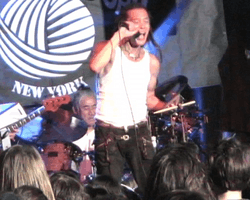 Caribbean-American-Japanese singer and actor Joe Yamanaka
Caribbean-American-Japanese singer and actor Joe Yamanaka- African-American-Japanese wrestler Aja Kong
_(19957109051).jpg) Haitian-Japanese professional tennis player Naomi Osaka
Haitian-Japanese professional tennis player Naomi Osaka
In recent history, the hike in the African-Japanese population has been linked to the American occupation of Japan following the end of World War II, where African-Japanese children were born through either prostitution or legally binding marriage. Thus, over the years, an increased number of African-American male/Japanese female unions has produced a culturally hybrid Black Japanese-American population living in Japan. Once given preferential treatment during the American military presence in Japan, the currently biracial population faces some severe public backlash and marginalization due to the reemergence of ethnic-based nationalism in Japan.[Asia-Japan 1] These unions between Asian women and American G.I.s have also contributed to the increase of the Afro-Asian orphan population. In some cases many Asian wives accompanied their husbands in returning to and settling in the United States. Subsequently, many African-Japanese are products of unions between Native Japanese and continental Africans due to the increased numbers of immigrant Africans.
Notables

Notable African-Japanese include American author and playwright Velina Hasu Houston who was born in territorial waters off the coast of Japan to a native-born Japanese mother of partial Japanese ancestry and an African-American father. Popular American-born enka singer Jero was born into a multi-generational African-Japanese-American family and immigrated back to the birth country of his grandmother. He has become one of the most famous Black/African descendants in the country. There is also native-born wrestler Aja Kong, former professional basketball player Michael Takahashi and pop/R&B singer Thelma Aoyama who were all born to Japanese mothers and African-American fathers. Current Japanese international basketball player and likely 2019 NBA draft first-round pick Rui Hachimura was born to a Japanese mother and Beninese father and sprinter Asuka Cambridge was born to a Japanese mother and Black Jamaican father. Australian soccer player Tando Velaphi was born to a Japanese mother and a Zimbabwean father.
Afro-fusion in Japanese media
Other resident Black African descendants famous in Japanese media include native-born ethnic African-American-Korean pop singer Crystal Kay and beauty queen Ariana Miyamoto.
South Korea



The U.S. deployment of forces to South Korea between 1950 and 1954 resulted in a multitude of Afro-Asian births, mostly between Native South Korean women and African-American servicemen. While many of these births have been to married Black/Korean interracial couples, others have been born out-of-wedlock through prostitution. Already facing the dilemma of 85,000 children left homeless throughout the country after the Korean War, South Korea saw a spike in orphaned Black Korean infants.[Asia-Korea 1] Often, the Afro-Korean orphans were purposely starved, as the society deemed mixed-raced children less worthy of food needed by non-mixed Korean children. In some areas, the mixed-raced youth were even denied education. In 1955, the U.S. State Department made a public plea asking American families to open their doors to the ostracized youth and in 1956 the Holt Adoption Program launched a gateway for Christian faith-based adoption of children of G.I. soldiers that also included Eurasian offspring. However, in addition to the race-based discrimination faced in their country of birth, Afro-Korean orphans were still passed over by adopting American families based on skin color preferences.[Asia-Korea 2] There is also a general stigma placed on Afro-Koreans based on illegitimacy, low socio-economic status, low educational attainment and aesthetics.[Asia-Korea 3]
Notable Koreans of Black African descent:
Europe
United Kingdom

The British Mixed-Race population includes some Afro-Asian people. This ancestry may stem from a multi-generational mixed Caribbean lineage, as well as interracial unions between Africans and Asians from prominent populations such as British Indians and British Nigerians. Notable Afro-Asian Britons include multigenerational Afro-Chinese-Caribbean-descended Naomi Campbell, first generation biracial Iranian-Ghanaian-descended actress Freema Agyeman and first-generation biracial Indo-Caribbean-descended musician David Jordan.
South Asia
India
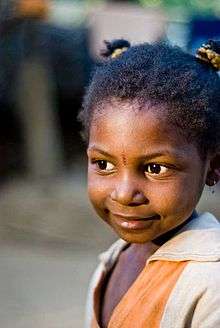
Slave trade and colonial era
The more recently emerged Afro-Asian population, the Siddi, resulting from the slave trade under Muslim, British and Portuguese occupation in India between the 7th and 19th centuries. Under a slightly different slave system from that of the Atlantic slave trade, slaves usually worked as domestics, tradesmen or military personnel and were encouraged to assimilate and intermarry within the existing population. With their own unique cultural identity, the population is about 50,000 strong. About a third of the Siddi reside in the state of Karnataka.
Pakistan
The Siddis or Makranis, are an ethnic group inhabiting India and Pakistan. Members are descended from Bantu peoples from the African Great Lakes region. Some were merchants, sailors and mercenaries. Others were indentured servants, but the vast majority were brought to the South Asia as slaves by Portuguese and Arab merchants.[15] The Siddi community is currently estimated at around 20,000–55,000 individuals in Makran and Karachi in Pakistan as the main population centres.[16] Siddis are primarily Sufi Muslims.[17]
Narang et al. (2011) examined the autosomal DNA of Siddis in Pakistan. According to the researchers, about 58% of the Siddis' ancestry is derived from Bantu peoples. The remainder is associated with local Indo-European-speaking North and Northwest Indian populations, due to recent admixture events.[18] However, Guha et al. (2012) observed few genetic differences between the Makrani of Pakistan and adjacent populations. According to the authors, the genome-wide ancestry of the Makrani was essentially the same as that of the neighboring Indo-European-speaking Balochi and Dravidian-speaking Brahui.[19]
Sri Lanka
The Sri Lanka Kaffirs are an ethnic group in Sri Lanka who are partially descended from 16th-century Portuguese traders and Bantu slaves with additional admixture from ethnic Sri Lankans who were brought by them to work as labourers and soldiers to fight against the Sinhala Kings.[15][20] They are very similar to the Zanj-descended populations in Iraq and Kuwait, and are known in Pakistan as Sheedis and in India as Siddis.[15] The Kaffirs spoke a distinctive creole based on Portuguese, the Sri Lanka Kaffir language, now extinct. Their cultural heritage includes the dance styles Kaffringna and Manja and their popular form of dance music Baila.
The term Kaffir is said to mean 'non-believer'. It does not hold the same meaning in Sri Lanka as it does in countries like South Africa, where it is used as a racial slur.[Asia-Sri Lanka 1]
Southeast Asia
Philippines
.jpg) Jaya is of Jamaican and Visayan descent.
Jaya is of Jamaican and Visayan descent.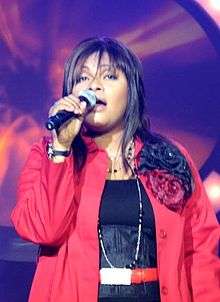 Mau Marcelo is of Afro-Puerto Rican and Filipino descent.
Mau Marcelo is of Afro-Puerto Rican and Filipino descent. apl.de.ap is of African-American and Filipino descent.
apl.de.ap is of African-American and Filipino descent.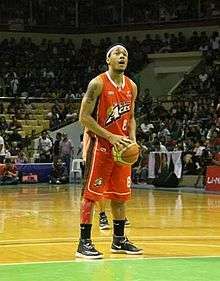 Calvin Abueva is of African-American and Filipino descent.
Calvin Abueva is of African-American and Filipino descent..jpg) Maverick Ahanmisi is of Nigerian and Filipino descent.
Maverick Ahanmisi is of Nigerian and Filipino descent. KG Canaleta is of African-American and Filipino descent.
KG Canaleta is of African-American and Filipino descent.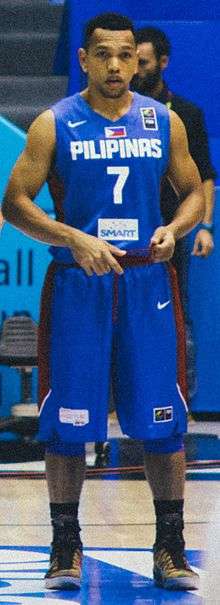 Jayson Castro is of African-American and Filipino descent.
Jayson Castro is of African-American and Filipino descent..jpg) Chris Newsome is of African-American and Filipino descent.
Chris Newsome is of African-American and Filipino descent..jpg) Jordan Clarkson is of African-American and Filipino descent.
Jordan Clarkson is of African-American and Filipino descent..jpg) Eric Cray is of African-American and Filipino descent.
Eric Cray is of African-American and Filipino descent.
Most older Afro-Filipinos were born from African-American G.I. and Filipino parentage. More recently, the Overseas Filipino Worker communities have produced interracial marriages with people of African descent in the Americas or Europe, resulting in Afro-Filipinos who may return to the country as natural born Filipinos. In 2011, The Nigerian Family Association notified the Republic of the Philippines Department of Foreign Affairs of its formation, opening membership to a growing number interracial Nigerian-Filipino/Filipino-Nigerian families and their children, living in the country.[21]
Afro-Filipinos are not subject to socio-economical, cultural, or political marginalization within Philippine society as other Afro-Asians may experience within more xenophobic neighboring Asian countries. This unique acceptance of Afro-Asians and biracials within the Philippines may be down to the full social integration of Afro-Asians who speak Philippine languages natively, Filipino familiarity with Aetas and other Negrito indigenous Filipinos who share some facial features and skin tones with Afro-Filipinos, popular affiliation to African-American culture and music as a relatable and non-colonial subculture, or positive Afro-Filipino representation internationally, reflecting their patriotism and affinity to the Philippines.
Their social positions vary widely, with some living in poor or working class areas, while most are lower middle or upper middle class citizens. Most Afro-Filipinos live in and around Metro Manila, Calabarzon, Metro Cebu, or in Olongapo, Clark, or Angeles cities in Central Luzon around the former American bases.
Many Afro-Filipinos represent the Philippines in international events like Kristina Knott and gold medalist Eric Cray (African-American-Filipino) in the 30th SEA games held in the Philippines in 2019, or Mau Marcelo, winner of Philippine Idol 2006. Afro-Filipino sportsmen gain popularity within the highly popular Philippine Basketball Association or on local TV and in the hospitality sectors.
Among the country's most recognizable Afro-Asians are half African-American/Filipino R&B singers Jaya, Mau Marcelo and Luke Mejares.
Singapore
Mixed marriages between ethnic Asians and foreigners are becoming more common in Singapore. While most mixed marriages between ethnic Asians and foreigners involve marriages between Europeans and Asians, some marriages have involved Africans and Asians. Afro-Asians born out of these mixed marriages have added to the mixed race population of Singapore.[22] The 2014 Miss Singapore Universe finalist Ijechi Nazirah Nwaozuzu is Afro-Asian.[23] Her mother is Malay with additional Portuguese, Indian and Chinese ancestry and her father is Nigerian.[24]
Vietnam
During the Vietnam War, African-American servicemen had children with local Vietnamese women. Some of these children were abandoned by the Vietnamese family or sent to orphanages. Many orphans and children were airlifted to adopting families in the United States in 1975 during "Operation Babylift" before the fall of South Vietnam. The Afro-Vietnamese (or Afro-Amerasian) children suffered much discrimination in Vietnam at that time.[Asia-Vietnam 1] There was also some controversy as to how these orphaned Afro-Amerasian children were placed in new homes in the United States.[Asia-Vietnam 2]
West Asia
Saudi Arabia
According to The World Factbook, around 10% of Saudi Arabia's population is of Afro-Asian descent.[25] Most Afro-Asians living in Saudi Arabia are Afro-Arabs, who occasionally face discrimination due to their dark skin.[26] Marriages between Native Saudi Arabs and Black Africans are quite common in Saudi Arabia.[27]
References
- Bird, Stephanie Rose (2009). Light, bright, and damned near white : biracial and triracial culture in America. ...he is also Blasian (Black-Asian)... Westport, Conn.: Praeger. p. 118. ISBN 978-0-2759-8954-5.
blasian definition.
- Reicheneker, Sierra (January 2011). "The Marginalization of Afro-Asians in East Asia: Globalization and the Creation of Subculture and Hybrid Identity". There Are Several Models for Analyzing the Marginalization of Ethnic Minorities. The Afro-Asian Population Exemplifies Park's Definition of Marginalization, in That They Are the "product of Human Migrations and Socio-cultural Conflict."15 Born into Relatively New Territory in the Area of Biracial Relations, There Entrance into the Culture of These Asian States Often Causes Quite a Stir. They Also Fit into Green and Goldberg's Definition of Psychological Marginalization, Which Constitutes Multiple Attempts at Assimilation with the Dominant Culture Followed by Continued Rejection. The Magazine Ebony, from 1967, Outlines a Number of Afro-Asians in Japan Who Find Themselves as Outcasts, Most of Which Try to Find Acceptance within the American Military Bubble, but with Varying Degrees of Success.16. 5 (1). Retrieved 4 July 2012.
- Kenya battling with Chinese prostitutes, arrests 15 at brothel
- Gemma Berniell-Lee; Stéphanie Plaza; Elena Bosch; Francesc Calafell; Eric Jourdan; Maya Cesari; Gérard Lefranc & David Comas (2008). "Admixture and Sexual Bias in the Population Settlement of La Réunion Island (Indian Ocean)". American Journal of Physical Anthropology. WILEY-LISS, INC. 136 (1): 100–107. doi:10.1002/ajpa.20783. PMID 18186507. Archived from the original on 5 January 2013. Retrieved 9 July 2010.
- Quintana-Murci, L; Harmant, C; Quach, H; Balanovsky, O; Zaporozhchenko, V; Bormans, C; van Helden, PD; Hoal, EG; Behar, DM (2010). "Strong maternal Khoisan contribution to the South African coloured population: a case of gender-biased admixture". Am. J. Hum. Genet. 86 (4): 611–20. doi:10.1016/j.ajhg.2010.02.014. PMC 2850426. PMID 20346436.
- Williams Madison, Paula "Finding Samuel Lowe - Documentary". findingsamuellowe.com. Retrieved on 25 February 2018.
- Handbook of Jamaica. Google Books: Jamaica Government. 1908. p. 37.
- Simms, Tanya M.; Wright, Marisil R.; Hernandez, Michelle; Perez, Omar A.; Ramirez, Evelyn C.; Martinez, Emanuel; Herrera, Rene J. (August 2012). "Y-chromosomal diversity in Haiti and Jamaica: contrasting levels of sex-biased gene flow". Am J Phys Anthropol. 148 (4): 618–31. doi:10.1002/ajpa.22090. PMID 22576450.
- Evaluation of Group Genetic Ancestry of Populations from Philadelphia and Dakar in the Context of Sex-Biased Admixture in the Americas Stefflova K, Dulik MC, Pai AA, Walker AH, Zeigler-Johnson CM, Gueye SM, Schurr TG, Rebbeck TR – PLoS ONE (2009).
- Love's revolution: interracial marriage by Maria P.P. Root. Page 180
- "Mitochondrial DNA Analysis of Four Ethnic Groups of Afghanistan" (PDF). Archived from the original (PDF) on 2 August 2017.
- Haber, Marc; Platt, Daniel E.; Bonab, Maziar Ashrafian; Youhanna, Sonia C.; Soria-Hernanz, David F.; Martínez-Cruz, Begoña; Douaihy, Bouchra; Ghassibe-Sabbagh, Michella; Rafatpanah, Hoshang; Ghanbari, Mohsen; Whale, John; Balanovsky, Oleg; Wells, R. Spencer; Comas, David; Tyler-Smith, Chris; Zalloua, Pierre A.; Consortium, The Genographic (28 March 2012). "Afghanistan's Ethnic Groups Share a Y-Chromosomal Heritage Structured by Historical Events". PLOS One. 7 (3): e34288. doi:10.1371/journal.pone.0034288. PMC 3314501. PMID 22470552.
- https://africachinareporting.co.za/2014/06/bride-and-prejudice-afro-chinese-marriages-in-guangzhou/
- https://www.theguardian.com/world/2010/oct/06/china-crackdown-african-immigration
- Shah, Anish M.; et al. (15 July 2011). "Indian Siddis: African Descendants with Indian Admixture". American Journal of Human Genetics. 89 (1): 154–161. doi:10.1016/j.ajhg.2011.05.030. PMC 3135801. PMID 21741027.
- Kumar Suresh Singh, Rajendra Behari Lal (2003), Gujarat, Anthropological Survey of India (Popular Prakashan), ISBN 978-81-7991-106-8
- Shanti Sadiq Ali (1996), The African dispersal in the Deccan, Orient Blackswan, ISBN 978-81-250-0485-1
- Narang, Ankita; et al. (15 July 2011). "Recent Admixture in an Indian Population of African Ancestry". American Journal of Human Genetics. 89 (1): 111–120. doi:10.1016/j.ajhg.2011.06.004. PMC 3135806. PMID 21737057.
- Guha, Saurav; et al. (25 January 2012). "Implications for health and disease in the genetic signature of the Ashkenazi Jewish population". Genome Biology. 13 (R2): R2. doi:10.1186/gb-2012-13-1-r2. PMC 3334583. PMID 22277159.
- "Archived copy". Archived from the original on 18 February 2015. Retrieved 18 February 2015.CS1 maint: archived copy as title (link)
- Republic of the Philippines Department of Foreign Affairs (15 October 2011). "Nigerian Filipino Families Association Officers Sworn in By Phl Ambassador". The Philippine Embassy in Abuja reported to the Department of Foreign Affairs that the officers of the newly formed, Abuja-based Nigerian Filipino Families Association (NFFA) were sworn in by Ambassador Nestor N. Padalhin on October 9 at the Embassy's Conference Room. The NFFA Officers, who will have a two-year tenure, are Grace Abrazado, President; Flora Adole, Vice President; Araceli Aipoh, Secretary and Communication Officer; Catalina Jibrin, Treasurer and Finance Officer; Esperanza Ogaga, Events Officer; Leony Ogu, Social Welfare Officer; and Hadiza Garba, Auditor and Logistics Officer. One of the main objectives of the association is to foster solidarity, strengthen friendship, and explore avenues of cooperation among the members of NFFA and their families, as well as with other members of the communities where they live. Membership is open to Filipinos married to Nigerians or Nigerians married to Filipinos, and their children. An annual fee of N6,000 (approximately US$40.00) to cover operating costs is to be paid by each member. In his message, Ambassador Padalhin, who wore a Nigerian attire made of adire for the occasion, congratulated the officers and members of the NFFA for their initiative in founding an association that involves their families, especially, he says, as this will ensure that the NFFA children will have more opportunities to know about Filipino culture. He mentioned about the possibility of the embassy and NFFA collaborating on cultural activities in the future. He said that while posted in Lebanon, he was instrumental in establishing the Filipino Lebanese Families Association. Meanwhile, Mrs. Abrazado said the association intends to work in cooperation with the Filipino community in Nigeria and the Embassy. She is the immediate past President of Pusong Pinoy Association (PPA), and currently the Vice President of the Abuja Branch of Nigerwives Nigeria. The swearing in was witnessed by Embassy officers and staff. Retrieved 5 August 2012.
- "Mixed marriages becoming more common in Singapore". 31 March 2013.
- "Blasian Finalist for Miss Universe Singapore". 25 August 2014.
- "Miss Universe finalists asked: Excuse me, are you S'porean?". 23 July 2014.
- "Middle East :: SAUDI ARABIA". CIA The World Factbook.
- "The New Arab - Dark-skinned and beautiful: Challenging Saudi Arabia's perception of beauty".
- "46 Saudis marry African women". 7 December 2015.
Africa
Congo
- Rabaud, Marlène; Zatjman, Arnaud (16 March 2010). "Katanga's forgotten people". France 24 International News. Retrieved 13 May 2012.
Like many mixed-race children in Congo, they were born of a Japanese father who came to work in the mines of Katanga in south-east of the country. Today, they accuse their fathers of wanting to kill them so as not to leave behind any traces when they returned to Japan.
Equatorial Guinea
-
Anshan, Li (2012). A History of Overseas Chinese in Africa to 1911. Diasporic Africa Press. p. 89. ISBN 978-0-966-02010-6.
The number of indentured Chinese laborers on these islands was estimated to be 1,500; Spanish Fernando Po Island was estimated to be 500.
Kenya
- Kristof, Nicholas D. (6 June 1999). "1492: The Prequel". The New York Times.
- Ancient Chinese Explorers, by Evan Hadingham
- Patton, Dominique. "Chinese companies eye Kenya's roads". Responding to a reporter’s question earlier this week about Chinese firms bringing many of their own workers to Africa, he said: “We seek common development for both China and African countries. We try to pursue common prosperity of both sides.” He added that China’s strong ties with Africa have provided many countries with “high quality projects, reduced construction costs” and faster construction times. The trend for growing investment on the continent certainly looks set to increase. Mr Chen said that “the Chinese business community has bucked the trend” this year, investing $875 million in Africa in the first nine months, an increase of 77.5 per cent over the same period of 2008. In total, China had invested $7.8 billion in the continent by the end of 2008. Business Daily. Retrieved 13 May 2012.
- Mbilu, Sally. "20yr Old Girl Looking for Her Chinese Baby Daddy". A 20-year-old girl from Murera in Ruiru, is frantically searching for a man of Chinese extraction she claims impregnated her last year. Patricia Nyeri, a student at Murera high school, camped at the Thika super highway construction site looking for the father of her child, who she says worked at the site, at the time. It was a search that saw her thoroughly scrutinize the men working at the site for hours, yet she failed to identify her baby's father, saying all the Chinese men looked alike. Citizen News – www.citizennews.co.ke. Retrieved 13 May 2012.
Madagascar
- Hurles, ME; Sykes, BC; Jobling, MA; Forster, P (May 2005). "The dual origin of the Malagasy in Island Southeast Asia and East Africa: evidence from maternal and paternal lineages". Am. J. Hum. Genet. 76 (5): 894–901. doi:10.1086/430051. PMC 1199379. PMID 15793703.
- A small cohort of Island Southeast Asian women founded Madagascar, by Murray P. Cox, Michael G. Nelson, Meryanne K. Tumonggor, François-X. Ricaut and Herawati Sudoyo
- Pan 1994, p. 157
Nigeria
- Flores, Maynard. "A Pinay 'Nigerwife' in Enugu". Guiller called to tell me about a Filipina doctor married to a Nigerian (hence the term Niger-wife), who had been living in Enugu for quite a while. I decided to look for her bakeshop. To my pleasant surprise, it was within walking distance from our lotto office. Archived from the original on 17 February 2013. Retrieved 5 August 2012.
I decided one day to pay her a visit at Faye's Bakeshoppe at Ogui Road. Only her Nigerian staff was there, but the moment they saw me, they asked if I was looking for my 'sister'. (In Nigeria, a compatriot or fellow-countryman is described as 'my brother' or 'my sister'.)
South Africa
- Staff, Editing (18 June 2008). "S Africa Chinese 'become black'". BBC News Africa. Retrieved 14 May 2012.
The laws give people classed as blacks, Indians and coloureds (mixed-race) employment and other economic benefits over other racial groups.
- DNA study from ancestry24 Archived 2 December 2012 at the Wayback Machine
The Americas
United States
- "Resident Population Data: Population Change". United States Census Bureau. 23 December 2010. Archived from the original on 25 December 2010. Retrieved 13 May 2012.
- "The United States". Chinese Blacks in the Americas. Color Q World. Retrieved 21 July 2008.
- Chin, Gabriel and Hrishi Karthikeyan, (2002) Asian Law Journal vol. 9 "Preserving Racial Identity: Population Patterns and the Application of Anti-Miscegenation Statutes to Asian Americans, 1910–1950". Papers.ssrn.com. Retrieved on 29 January 2012.
- "The United States". Chinese blacks in the Americas. Color Q World. Retrieved 15 July 2008.
- Susan Dente Ross; Paul Martin Lester (2011). Images That Injure: Pictorial Stereotypes in the Media. ABC-CLIO. p. 144. ISBN 978-0-313-37892-8.
Mississippi
- Wilson, Charles Reagan (2002) Mississippi History Now: An online publication of the Mississippi Historical Society "Chinese in Mississippi: An Ethnic People in a Biracial Society". mshistorynow.mdah.ms.gov. Retrieved on 25 February 2018.
The Caribbean
Cuba
- Identity, Rebellion, and Social Justice Among Chinese Contract Workers in Nineteenth-Century Cuba Archived 20 February 2012 at the Wayback Machine
- David Stanley (1997). Cuba: a Lonely Planet travel survival kit. Lonely Planet. ISBN 978-0-86442-403-7.
- CIA – The World Factbook. Cia.gov. Retrieved on 2012-05-09.
- Mendizabal, I; Sandoval, K; Berniell-Lee, G; Calafell, F; Salas, A; Martínez-Fuentes, A; Comas, D (2008). "Genetic origin, admixture, and asymmetry in maternal and paternal human lineages in Cuba". BMC Evolutionary Biology. 8: 213. doi:10.1186/1471-2148-8-213. PMC 2492877. PMID 18644108.
Jamaica
South America
Peru
- Taste of Peru Archived 27 September 2013 at the Wayback Machine. Taste of Peru. Retrieved on 29 January 2012.
East Asia
China
- Reicheneker, Sierra (January 2011). "The Marginalization of Afro-Asians in East Asia: Globalization and the Creation of Subculture and Hybrid Identity". 5 (1). Retrieved 4 July 2012.
In China, the Afro-Asian People Group is a Newer Phenomenon.9 They First Began to Appear Beginning with African-American and African Students Coming to Study in China, First in the City of Beijing and Later in Other Larges Cities, Such as Nanjing,10 Hangzhou, and Shanghai.
Cite journal requires|journal=(help) - Branigan, Tania (6 October 2010). "China cracks down on African immigrants and traders". the Guardian.
- Porzucki, Nina. "In Southern China, A Thriving African Neighborhood". NPR – WBUR, Boston. Retrieved 14 May 2012.
Today, the city of Guangzhou, near Hong Kong, is home to some 10,000 Africans, the largest such community in China. The city's Little Africa neighborhood is a world unto itself, with restaurants specializing in African food to money changers who deal in the Nigerian currency.
- Beja, Patrick. "Project seeks to confirm roots of "Lamu Chinese"". The Standard Online. Retrieved 14 May 2012.
Badishee's daughter Mwamaka Sharifa got a scholarship to study medicine in China five years ago. The NMK Director General Idle Farah confirmed the Chinese Government offered a girl from the area a scholarship about five years ago to study medicine in Beijing after discovering the families who bear Chinese features.
- Chang, Emily. "TV talent show exposes China's race issue". CNN. Retrieved 14 May 2012.
Lou Jing was born 20 years ago in Shanghai to a Chinese mother and an African-American father. According to her mother, who asked not to be identified in this report, she met Lou's father while she was still in college. He left China before their daughter was born. Lou Jing's background became fodder for national gossip, sparking a vitriolic debate about race across a country that, in many respects, can be quite homogenous. There are 56 different recognized ethnic groups in China, but more than 90 percent of the population is Han Chinese. So people who look different standout.
Japan
- Reicheneker, Sierra (January 2011). "The Marginalization of Afro-Asians in East Asia: Globalization and the Creation of Subculture and Hybrid Identity". Global Tides. 5 (1). Retrieved 4 July 2012.
The products of both prostitution and legally binding marriages, these children were largely regarded as illegitimate. When the military presence returned to America, the distinction between the two was, for all practical purposes, null. As the American military departed, any previous preferential treatment for biracial people ended and was replaced with a backlash due to the return of ethnically-based national pride.
South Korea
- Staff, Editing (24 March 1955). "State Department Seeks to Help 'Ostracized' Korea Brown Babies". Jet Magazine. Retrieved 14 May 2012.
The State Department announced that U.S. homes are needed for an estimated 200 children of Negro-Oriental romances who being "ostracized" and kept "hungry" in South Korean orphanages. The part-Negro tots, whose G.I. fathers fought with the UN forces, face a dismal future in Korea, where an estimated 85,000 children are homeless as a result of the recent war. Housed in poorly-equipped orphanages, they are "unwanted" and looked down upon by the Orientals. Government officials charged that some of the mixed-blood children are denied sufficient food by Koreans, who argue that "there is no need to give them food that is so much needed by our own children." In some places the children are not permitted to attend school. Because of the tragic situation, welfare aides believe that one of the best solutions to the problem is to bring the part-Negro orphans to the U.S. However, refugee program aide Harry B. Lyford said, "Very few inquiries have come so far from prospective adoptive parents." To spur such an adoption program, government officials announced they will help U.S. Negro families interested in adopting the children and that all inquiries should be addressed to Lyrford at the Refugee Relief Program, State Department, Washington, D.C.
-
Hyun Jung Oh, Arissa (2011). Into the Arms of America: The Korean Roots of International Adoption. Chicago, Illinois. p. 273. ISBN 978-1-2439-8826-3.
This was especially problematic in the case of Korean black children, whose coloring was so important to their placement. In a memo to ISS Korea, Margaret Valk asked bout the possibility of sending better quality photographs to facilitate the adoptions of Korean black children. It has also been recently suggested to us by one of the agencies who may be able to suggest some Negro families for part-Negro children that if the snapshots of part-Negro children could be taken in color as well as in black and white, this would give the families and local agency here a much better idea of the child's skin coloring and help them in the matching process. Of course, this is not foolproof at all. Some colored photographs come out much darker and some much lighter depending upon the way in which they have been taken but with the black and white photograph (which must not be omitted). The adoption agency believes they could do a better job. As you know, the color of the skin is the most important when discussing a child with a Negro family. Do you have some access to colored film in Korea or would we need to try to send this to you?
- Reicheneker, Sierra (January 2011). "The Marginalization of Afro-Asians in East Asia: Globalization and the Creation of Subculture and Hybrid Identity". Global Tides. 5 (1): 26. Retrieved 4 July 2012.
In Korea, the majority of Amerasian and Afro-Asian children left behind after the Korean War are orphans. In Korea’s society, like most in East Asia, success hinges on the family, particularly on the father, due to the emphasis placed upon and legacy of Confucian values. Growing up without parents, or in many situations with only a mother, has left Afro-Asians ostracized by society. Low educational levels and unemployment run rampant. In his work on Black Koreans, Won Moo Hurh outlines four specific common problems they face: first, their illegitimate status, which is still heavily stigmatized in Korea. Second, their mother’s presumed prostitute and low economic status is looked down upon, even though many women were legally married to their military husbands. Korean society has absorbed the stereotype that all mothers of biracial children are low-class, "sexual pariahs." Third, without a strong family background, there is usually a lack of higher education and subsequent difficulty in finding work. Lastly, Hurh describes their discrimination based on appearance. Facing these problems of marginalization, Black Koreans have naturally taken on a negative self-image. Hurh says they "carry the heaviest... burden of stigmas."
Europe
South Asia
Pakistan
Sri Lanka
- Gunasekera, Mel (20 November 2009). "Where 'kaffir' is no insult". The Daily Telegraph. London.
Southeast Asia
Philippines
Vietnam
- Anderson, Wanni Wibulswasdi; Lee, Robert G., Displacements and Diasporas: Asians in the Americas, Rutgers University Press, 2005. ISBN 0-8135-3611-1. For discrimination in Vietnam, cf. p.14. "In another case study, the Vietnamese Afro-Amerasians (Lucious, this volume) suffered severe discrimination in Vietnam, being called 'children of the enemy' ..." And further on p.133, "In Vietnam, Afro-Amerasians experienced the most discrimination because their black skin was perceived as relatively darker than the skin color of other Vietnamese people (especially White Euro-Amerasians)."
- Hicks, Nancy (19 April 1975). "Black Agencies Charge Injustice in Placing of Vietnam Children". The New York Times.